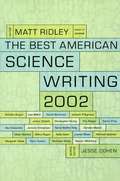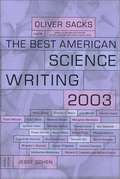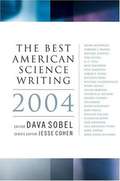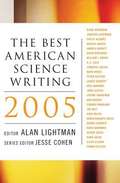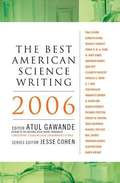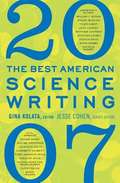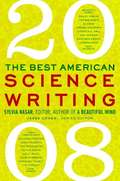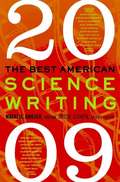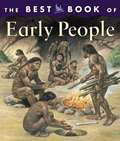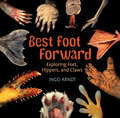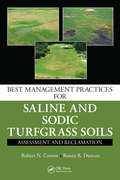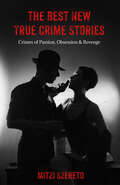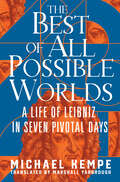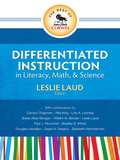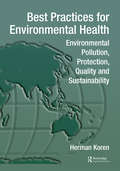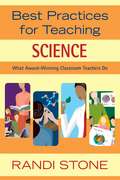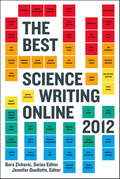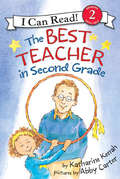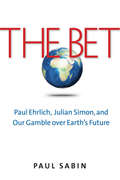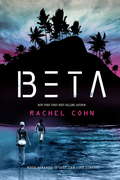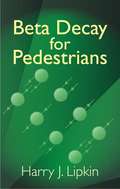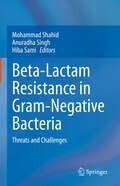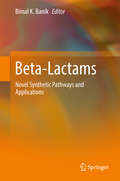- Table View
- List View
The Best American Science Writing 2002
by Matt Ridley Alan LightmanIf, as Matt Ridley suggests, science is simply the search for new forms of ignorance, then perhaps it follows that with science's advances come new questions. Will human genetic engineering become commonplace? Will human cloning ever be safe? Are there many universes? How much will the climate change during the coming century? The Best American Science Writing 2002 gathers top writers and scientists covering the latest developments in the fastest-changing, farthest-reaching scientific fields, such as medicine, genetics, computer technology, evolutionary psychology, cutting-edge physics, and the environment. Among this year's selections: In "The Made-to-Order Savior," Lisa Belkin spotlights two desperate families seeking an unprecedented cure by a medically and ethically unprecedented means -- creating a genetically matched child. Margaret Talbot's "A Desire to Duplicate" reveals that the first human clone may very likely come from an entirely unexpected source, and sooner than we think. Michael Specter reports on the shock waves rippling through the field of neuroscience following the revolutionary discovery that adult brain cells might in fact regenerate ("Rethinking the Brain"). Christopher Dickey's "I Love My Glow Bunny" recounts with sly humor a peculiar episode in which genetic engineering and artistic culture collide. Natalie Angier draws an insightful contrast between suicide terrorists and rescue workers who risk their lives, and finds that sympathy and altruism have a definite place in the evolution of human nature, David Berlinski's "What Brings a World into Being?" ponders the idea of biology and physics as essentially digital technologies, exploring the mysteries encoded in the universe's smallest units, be they cells or quanta. Nicholas Wade shows how one of the most controversial books of the year, The Skeptical Environmentalist, by former Greenpeace member and self-described leftist Bjorn Lomborg, debunks some of the most cherished tenets of the environmental movement, suggesting that things are perhaps not as bad as we've been led to believe. And as a counterpoint, Darcy Frey's profile of George Divoky reveals a dedicated researcher whose love of birds and mystery leads to some sobering discoveries about global warming and forcefully reminds us of the unsung heroes of science: those who put in long hours, fill in small details, and take great trouble. In the end, the unanswered questions are what sustain scientific inquiry, open new frontiers of knowledge, and lead to new technologies and medical treatments. The Best American Science Writing 2002 is a series of exciting reports from science's front lines, where what we don't know is every bit as important as what we know.
The Best American Science Writing 2003
by Oliver SacksIn his introduction to The Best American Science Writing 2003, Dr. Oliver Sacks, whom the New York Times has called "the poet laureate of medicine," writes that "the best science writing ... cannot be completely 'objective' -- how can it be when science itself is so human an activity? -- but it is never self-indulgently subjective either. It is, at best, a wonderful fusion, as factual as a news report, as imaginative as a novel." It is with this definition of "good" science writing in mind that Dr. Sacks has selected the twenty-five extraordinary pieces that make up the latest installment of this acclaimed annual. This year, Peter Canby travels into the heart of remote Africa to track a remarkable population of elephants; Atul Gawande shows us the way doctors learn their skills by performing supposedly routine procedures on unsuspecting patients. With candor and tenderness, Floyd Skloot observes the toll Alzheimer's disease is taking on his ninety-one-year-old mother, and is fascinated by the memories she retains. Marcelo Gleiser asks: If we are the universe's sole intelligent species, then what must we do to be good citizens of the cosmos? Natalie Angier writes about the challenge of traveling to distant stars. Gunjan Sinha explores the mating behavior of the common prairie vole and what it reveals about the human pattern of monogamy. Michael Klesius attempts to solve what Darwin called "an abominable mystery": How did flowers originate? Lawrence Osborne tours a farm where a genetically modified goat produces the silk of spiders in its milk. Joseph D'Agnese visits a home for retired medical research chimps. And in the collection's final piece, Richard C. Lewontin and Richard Levins reflect on how the work of Stephen Jay Gould demonstrated the value of taking a radical approach to science. As this series firmly attests, science writing has achieved a central place in our culture, and one can posit that the reason why has to do with the special thrill of discovery that a cogent piece of science writing can elicit. As Dr. Sacks writes of Stephen Jay Gould -- to whose memory this year's anthology is dedicated -- an article of his "was never predictable, never dry, could not be imitated or mistaken for anybody else's." The same can be said of all of the writing contained in contributions to this diverse collection "that can be enjoyed by laymen, scientists, and writers alike" (Nature).
The Best American Science Writing 2004
by Dava Sobel Jesse CohenWhat makes the articles found in The Best American Science Writing 2004 "the best"? As Dava Sobel, best-selling author of Longitude and Galileo's Daughter, writes in her introduction, "First and most important, all are extremely well written. This sounds obvious, and it is, but for me it means the pieces impart genuine pleasure via the writers' choice of words and the rhythm of their phrases... 'I wish I'd written that,' was my own frequent reaction to the articles I ultimately chose." This year, Jennifer Kahn's "Stripped for Parts" was selected as the lead story because, as Sobel reveals, "it begins with one of the most arresting openings I have ever read. " In "Columbia's Last Flight," William Langewiesche recounts the February 1, 2003, space shuttle tragedy, along with the investigation into the nationwide complacency that brought the ship down. K. C. Cole's "Fun with Physics" is a profile of astrophysicist Janet Conrad that blends her personal life with professional activity. In "Desperate Measures," the doctor and writer Atul Gawande profiles the surgeon Francis Daniels Moore, whose experiments in the 1940s and '50s pushed medicine harder and farther than almost anyone had contemplated. Also included is a poem by the legendary John Updike, "Mars as Bright as Venus." The collection ends with Diane Ackerman's "ebullient" essay "We Are All a Part of Nature. " Together these twenty-three articles on a wide range of today's most current topics in science -- from biology, physics, biotechnology, and astronomy, to anthropology, genetics, evolutionary theory, and cognition -- represent the full spectrum of scientific writing from America's most prominent science authors, proving once again that "good science writing is evidently plentiful" ( Scientific American ).
The Best American Science Writing 2005
by Alan LightmanToday's most prominent thinkers provide enlightening insight into some of the most important and cutting-edge topics in the field in this acclaimed series.
The Best American Science Writing 2006
by Atul GawandeTogether these twenty-one articles on a wide range of today's most leading topics in science, from Dennis Overbye, Jonathan Weiner, and Richard Preston, among others, represent the full spectrum of scientific inquiry, proving once again that good science writing is evidently plentiful.
The Best American Science Writing 2007
by Gina KolataProvocative and engaging, this collection brings together the premiere science writing of the year. The Best American Science Writing 2007 is a compelling anthology of our most advanced, and most relevant, scientific inquiries.
The Best American Science Writing 2008
by Sylvia NasarEdited by Sylvia Nasar, bestselling author of A Beautiful Mind and former economics correspondent for the New York Times, The Best American Science Writing 2008 brings together the premiere science writing of the year. Distinguished by the foremost voices and publications--among them Pulitzer Prize-winner Amy Harmon, Nobel Prize-winner Al Gore, and award-winning and bestselling author Oliver Sacks--this anthology is a comprehensive overview of our most advanced and most relevant scientific inquiries.
The Best American Science Writing 2009
by Natalie AngierDistinguished by new and impressive voices as well as some of the foremost names in science writing--Oliver Sacks and Atul Gawande among them--this anthology provides a comprehensive overview of where science has taken us--and where it is headed.
The Best Book of Early People
by Margaret Hynes Mike WhiteChildren are very curious about who their prehistoric ancestors were, how they lived, and what they may have looked like, and The Best Book of Early People by Margaret Hynes and Mike White is just the source to satisfy emerging anthropologists. Children will learn how early families survived, hunted, gathered into primitive settlements, began to use tools, and invented farming techniques. Step-by-step illustrations and captions explore ancient villages and the work of the scientists who find and catalog their discoveries.
Best Foot Forward: Exploring Feet, Flippers, and Claws
by Ingo ArndtWhose foot is this? An intriguing close-up of an animal's foot piques curiousity that's satisfied on the following page with a stunning full-size photo of the animal itself and a brief description of how the foot is used. A tiger stalks its prey on velvet paws. A gecko's ribbed feet enable it to climb walls as smooth as glass. The mole uses its feet for digging. The webbed feet of a duck help it swim. Rabbits and kangaroos have feet adapted for jumping fast and far. Caterpillars, starfish, and octopuses all use their feet to grab hold. The guessing-game format makes learning about natural adaptation fun. Includes an index of all animals illustrated.
Best Management Practices for Saline and Sodic Turfgrass Soils: Assessment and Reclamation
by Robert N. Carrow Ronny R. DuncanThe complex issues involved in the management of saline and sodic turfgrass soils are enough to perplex even the most experienced site manager- there is no "silver bullet" amendment, treatment, or grass for salinity management. Best Management Practices for Saline and Sodic Turfgrass Soils: Assessment and Reclamation presents comprehensive scientif
The Best New True Crime Stories: Serial Killers (The\best New True Crime Stories Ser.)
by Mitzi SzeretoObsession, Unrequited Love, Jealousy, Revenge, and Violence Collide in this Page-Turning Anthology#1 New Release in Forensic Science Law and Hoaxes & DeceptionsCrimes of passion are both eerie and strangely tantalizing. How can someone you hold dear become someone you fear? This riveting anthology explores the question through some of the most compelling true crime accounts and stories of obsession and vengeance.Crimes fueled by emotions. Love, passion, obsession, jealousy, and betrayal. When it comes to the emotions, people can react in strange and unexpected ways. Whether it’s a heart hurt by unrequited love, or a lover so passionate they’ll stop at nothing to get their way—even the most mild-mannered soul can suddenly flip, becoming a vengeful spirit with dark intentions. From the ancient Greek myth of Jason and Medea to Shakespeare’s Othello, themes dealing with deeply felt emotions have persisted. But unlike mythology or fiction, The Best New True Crime Stories: Crimes of Passion, Obsession & Revenge contains stories from real life.A special selection of stories written exclusively for this book. The Best New True Crime Stories: Crimes of Passion, Obsession & Revenge includes stories from around the world and from different times. As with all titles in the popular The Best New True Crime Stories series, this volume contains original nonfiction accounts penned by writers from across the literary spectrum. Dive into these twisted true tales of passion and unrequited love turned violent. Examine why some have fully embraced their dark side, resorting to crime to achieve their own special brand of satisfaction and retribution.If you enjoyed Mitzi's last book in her series, The Best New True Crime Stories: Well-Mannered Crooks, Rogues & Criminals, and books like You Love Me, and The Big Book of Serial Killers Volume 2, then you’ll love The Best New True Crime Stories: Crimes of Passion, Obsession & Revenge.
The Best of All Possible Worlds: A Life of Leibniz in Seven Pivotal Days
by Michael KempeA biography of the polymath Gottfried Wilhelm Leibniz told through seven critical days spanning his life and revealing his contributions to our modern world. Gottfried Wilhelm Leibniz (1646–1716) was the Benjamin Franklin of Europe, a “universal genius” who ranged across many fields and made breakthroughs in most of them. Leibniz invented calculus (independently from Isaac Newton), conceptualized the modern computer, and developed the famous thesis that the existing world is the best that God could have created. In The Best of All Possible Worlds, historian and Leibniz expert Michael Kempe takes us on a journey into the mind and inventions of a man whose contributions are perhaps without parallel in human history. Structured around seven crucial days in Leibniz’s life, Kempe’s account allows us to observe him in the act of thinking and creating, and gives us a deeper understanding of his broad-reaching intellectual endeavors. On October 29, 1675, we find him in Paris, diligently working from his bed amid a sea of notes, and committing the integral symbol—the basis of his calculus—to paper. On April 17, 1703, Leibniz is in Berlin, writing a letter reporting that a Jesuit priest living in China has discovered how to use Leibniz’s binary number system to decipher an ancient Chinese system of writing. One day in August 1714, Leibniz enjoys a Viennese coffee while drawing new connections among ontology and biology and mathematics. The Best of All Possible Worlds transports us to an age defined by rational optimism and a belief in progress, and will endure as one of the few authoritative accounts of Leibniz’s life available in English.
The Best of Corwin: Differentiated Instruction in Literacy, Math, and Science
by Leslie E. LaudContent-specific DI guidance from the best minds in education In this collection, current research on the most effective differentiation practices for differentiating instruction in literacy, mathematics, and scienceis brought alive through the many strategies and examples. Topics covered include: Reading and writing: A comprehensive array of models for differentiating reading instruction; gradual release of responsibility to accelerate progress; and multi-tiered writing instruction Mathematics: Support for both low- and high-achieving students, including interventions and challenges, and the implementation of RTI in math instruction Science: Models and methods for increasing student achievement through differentiated science inquiry
Best Practices for Environmental Health: Environmental Pollution, Protection, Quality and Sustainability (Best Practices for Public Health)
by Herman KorenIn a present where there are countless opportunities for the spread of exotic diseases, the expansion and creation of far more illness in our global population through globalization and rapid transportation, and the contamination of water, air and land, we find ourselves accountable. In this day and age we are confronted by global warming, Ebola, the Zika virus, lead in our water supply, enormous problems of infrastructure including aging sewer lines, water lines, electrical grids, roads and bridges, and the list goes on and on. Best Practices for Environmental Health: Environmental Pollution, Protection, Quality and Sustainability is a one source major response to all of the environmental issues that affect global health and the worldwide protection and preservation of the natural environment. It compiles broad-based and comprehensive coverage of environmental topics, broken down by specialized fields. Topics range from children’s environmental health to food protection and technology, water and waste systems, infection control, bioterrorism and pandemic health emergencies, and HAZMAT. Plus, it includes an overview of the current state of the profession and sections on programmatic techniques. This book helps solve the problems of disease and injury by presenting expert, evidence-based best practices. This first of the kind handbook is essential reading for all environmental and public health undergraduate students, as well as a fantastic overview for professionals in all environmental health, pollution and protection areas.
Best Practices for Teaching Science: What Award-Winning Classroom Teachers Do
by Randi StoneLet Randi Stone and her award-winning teachers demonstrate tried-and-tested best practices for teaching science in diverse elementary, middle, and high school classrooms. Linked to companion volumes for teaching writing and mathematics, this resource for new and veteran educators helps build student confidence and success through innovative approaches for raising student achievement in science, such as: Expeditionary learning, technology and music, and independent research study Model lessons in environmental studies and real-world science Inquiry-based strategies using robotics, rockets, straw-bale greenhouses, "Project Dracula," "Making Microbes Fun," and more! With engaging activities weaving through science fact and fiction to lead learners on intriguing journeys of discovery, this guide is sure to fascinate and inspire both you and your students!
Best Practices for Transportation Agency Use of Social Media
by Susan Bregman Kari Edison WatkinsTimely updates, increased citizen engagement, and more effective marketing are just a few of the reasons transportation agencies have already started to adopt social media networking tools. Best Practices for Transportation Agency Use of Social Media offers real-world advice for planning and implementing social media from leading government practit
The Best Science Writing Online 2012
by Bora Zivkovic and Jennifer OuelletteShowcasing more than fifty of the most provocative, original, and significant online essays from 2011, The Best Science Writing Online 2012 will change the way we think about science— from fluids to fungi, poisons to pirates. Featuring noted authors and journalists as well as the brightest up-and-comers writing today, this collection provides a comprehensive look at the fascinating, innovative, and trailblazing scientific achievements and breakthroughs of 2011, along with elegant and thought-provoking new takes on favorite topics. This is the sixth anthology of online essays edited by Bora Zivkovic, the blogs editor at Scientific American, and with each new edition, Zivkovic expands his fan base and creates a surge of excitement about upcoming compilations. Now everyone's favorite collection will reach new horizons and even more readers. Guest-edited and with an introduction by the renowned science author and blogger Jennifer Ouellette, The Best Science Writing Online 2012 marries cutting-edge science with dynamic writing that will inspire us all.
The Best Teacher in Second Grade (I Can Read Level 2)
by Katharine KenahThis heartfelt story shows the difference a good teacher can make in a student’s life!Luna has the best teacher in second grade. Mr. Hopper loves the midnight sky almost as much as Luna does, but the rest of the class isn’t on the same page. They won’t listen to her ideas for the Family Night program—until something goes unexpectedly wrong! With a nudge from Mr. Hopper, Luna shares her plan, which just might save the show.From the team that wrote and illustrated The Best Seat in Second Grade and The Best Chef in Second Grade, this appealing story will appeal to all second graders, as well as their parents, caregivers, and, especially, teachers!This Level Two I Can Read is geared toward kids who read on their own but still need a little help. Whether shared at home or in a classroom, the engaging stories, longer sentences, and language play of Level Two books are proven to help kids take their next steps toward reading success.
The Bet
by Paul SabinIn 1980, the iconoclastic economist Julian Simon challenged celebrity biologist Paul Ehrlich to a bet. Their wager on the future prices of five metals captured the publics imagination as a test of coming prosperity or doom. Ehrlich, author of the landmark book "The Population Bomb, " predicted that rising populations would cause overconsumption, resource scarcity, and famine--with apocalyptic consequences for humanity. Simon optimistically countered that human welfare would flourish thanks to flexible markets, technological change, and our collective ingenuity. Simon and Ehrlichs debate reflected a deepening national conflict over the future of the planet. "The Bet" weaves the two mens lives and ideas together with the eras partisan political clashes over the environment and the role of government. In a lively narrative leading from the dawning environmentalism of the 1960s through the pivotal presidential contest between Jimmy Carter and Ronald Reagan and on into the 1990s, Paul Sabin shows how the fight between Ehrlich and Simon--between environmental fears and free-market confidence--helped create the gulf separating environmentalists and their critics today. Drawing insights from both sides, Sabin argues for using social values, rather than economic or biological absolutes, to guide societys crucial choices relating to climate change, the planets health, and our own.
Beta: A Beta Novel (A Beta Novel)
by Rachel CohnElysia was born without a soul, her only purpose to serve the wealthy inhabitants of Io, an island paradise. But sensations are clouding her mind...anger...loneliness???love. Before long, Elysia learns that she is a Defect. And If any human on the island discovers the truth, it will cost her her life.
Beta Decay for Pedestrians
by Harry J. LipkinThe "pedestrian approach" was developed to describe some essentially simple experimental results and their theoretical implications in plain language. In this graduate-level text, Harry J. Lipkin presents simply, but without oversimplification, the aspects of beta decay that can be understood without reference to the formal theory; that is, the reactions that follow directly from conservation laws and elementary quantum mechanics.The pedestrian treatment is neither a substitute for a complete treatment nor a watered-down version. Its derivation of results obtainable without the formal theory makes these results more understandable and less mysterious to those who have neither the time nor the inclination to master the details of the theory. On the other hand, those already acquainted with the formal theory will find in the pedestrian treatment a clear distinction between results dependent on the specific assumptions underlying the formal theory and those independent of these assumptions, which follow from simple general principles. Since peculiar experimental results are an ever-present possibility, it is always useful to have a simple method of evaluating challenges to theoretical assumptions or approximations.
Beta-Lactam Resistance in Gram-Negative Bacteria: Threats and Challenges
by Mohammad Shahid Anuradha Singh Hiba SamiThis timely book discusses antimicrobial drug resistance, specifically, the resistance against the beta-lactam class of antibiotics by Gram-Negative bacteria. The book is broadly divided into five sections. The first section describes the underlying mechanisms of antimicrobial resistance in Gram-negative bacteria. It gives an insight into the beta-lactamases, their types, classification, inhibitors, etc. The second section delves deep into the genetic basis of resistance. It talks about transposons, integrons, insertion sequences associated with antibiotic-resistant genes. The next section describes phenotypic and molecular methods to detect beta-lactam resistance. The fourth section talks about the epidemiology and prevalence of beta-lactamases in the environment. The last section of the book describes the various therapeutic options to combat this growing public threat of antimicrobial resistance. It talks about the current reserve drugs, as well as the newer antibiotic agents that are in the pipeline. This book is essential for clinical practitioners, students, and researchers in basic and medical microbiology.
Beta-Lactams: Novel Synthetic Pathways and Applications (Topics In Heterocyclic Chemistry Ser. #30)
by Bimal K. BanikI. Ojima * E. S. Zuniga * J. D. Seitz: Advances in the Use of Enantiopure β-Lactams for the Synthesis of Biologically Active Compounds of Medicinal Interests. - I. Fernández * Miguel A. Sierra: β -Lactams from Fischer Carbene Complexes: Scope, Limitations, and Reaction Mechanism. - Bablee Mandal * Basudeb Basu: Synthesis of β-Lactams Through Alkyne-Nitrone Cycloadditions. - T. T. Tidwell: Preparation of Bis-β-Lactams by Ketene-Imine Cycloadditions. - Edward Turos: The Chemistry and Biology of N-Thiolated β-Lactams. - Indrani Banik * Bimal K. Banik: Synthesis of β-Lactams and Their Chemical Manipulations Via Microwave-Induced Reactions.
